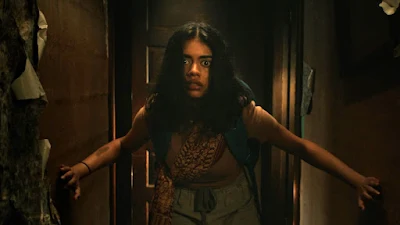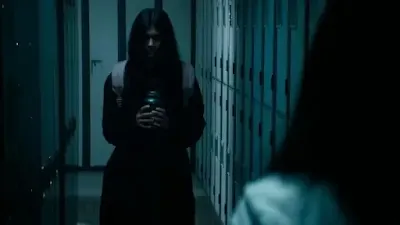It Lives Inside Movie in English Review
The narrative commences with a conventional shot, a camera traversing through a modest yet dilapidated home. Within the residence's corridors lie lifeless, crumpled bodies, while screams reverberate from a partially open door leading to the basement. Descending creaky stairs, we encounter a severely burned body, steam still emanating from the charcoaled skin, its hand reaching towards a glass jar filled with black smoke—a symbolic vessel encapsulating the challenges faced by the Indian inhabitants in this predominantly white suburb.
"It Lives Inside," Bishal Dutta's directorial debut, navigates cultural mythology and familiar atmospheric frights to unfold the narrative of Samidha (portrayed captivatingly by Megan Suri). Samidha, commonly known as Sam, is an intelligent and popular student grappling with typical teenage experiences—a domineering mother (Neeru Bajwa) and a crush on the school heartthrob, Gage Marsh. Her former best friend, Tamira (Mohana Krishnan), is undergoing a tumultuous phase, marked by sleep deprivation and self-conversations, carrying the same enigmatic jar seen earlier.
Concerned, her teacher Joyce (Betty Gabriel) implores Sam to connect with Tamira. Unfortunately, Sam resists associating herself with the perceived "crazy" Brown person, dismissing Joyce's pleas for solidarity. She initially disregards Tamira's accounts of a haunting specter. Sam's skepticism fades when she inadvertently shatters the jar, leading to Tamira's mysterious disappearance. A ghoul, with a disconcerting composition of tiny teeth, infiltrates Sam's dreams, initiating attacks on those around her. The film aspires to blend a teen movie ambiance with an allegory of the immigrant experience, yet falls short of seamless cohesion.
Drawing parallels to "The Babadook," viewers may analyze the mechanics of the film's monster, a Pishach, showcasing a propensity to isolate victims and manipulate their psyche. The ancient being from Hindu and Buddhist mythology predates Jennifer Kent's film, illustrating the universality of how loneliness can distort the mind. The narrative explores the sense of othering and assimilation experienced by Black and Brown individuals within a predominantly white environment. Sam, striving to fit in, distances herself from her Indian identity, opting for micro-aggressive white companionship over Tamira, refraining from speaking Hindi, and avoiding inviting anyone to her home. These decisions create conflict with her traditionalist mother, echoing the typical tensions between first-generation Americans and their parents.
While there are glimpses of a potential exploration of the immigrant experience, akin to Remi Weekes' "His House," the film primarily fixates on crafting a suburban teen narrative, albeit with less success. Sam's desire for social acceptance, driven by fear of cultural repercussions, leads her to witness a friend's murder without evident repercussions at school. The narrative overlooks the expected reactions in an area suspicious of Brown individuals, with no police involvement, parental outreach, or confrontations within the community. The film's attempt to be a teen movie relies on basic elements borrowed from superior films rather than immersing viewers in an authentic milieu.
The visual language imposes constraints on the viewer; although close-ups provide an immersive touch, the overused double dolly shot, reminiscent of Spike Lee's style, diminishes in impact with each repetition. Poorly executed match cuts and lackluster sound design contribute to the film's overall shortcomings. The climax, a prolonged showdown in a basement between Sam and the monster, loses rhythm and pace, seemingly orchestrated for a potential sequel.
While the premise of telling an Indian-American horror story set in suburbia holds promise, "It Lives Inside" falters due to major deficiencies in plot, themes, and tension. The film, now playing in theaters
Frequently Asked Questions (FAQs) - "It Lives Inside"
What is the movie "It Lives Inside" about?
"It Lives Inside" follows the story of Samidha (Megan Suri), a smart and popular student navigating the challenges of being an Indian inhabitant in a predominantly white suburb. The film blends cultural mythology with traditional horror elements, exploring the consequences of cultural assimilation and a supernatural presence haunting Samidha's life.
Is "It Lives Inside" worth watching?
The film has received mixed reviews, with some praising its attempt to blend cultural themes with horror, while others criticize its execution and narrative shortcomings. Whether it's worth watching depends on individual preferences for horror films with cultural allegories.
Can you share a spoiler summary of "It Lives Inside"?
In the film, the ghoul, identified as a Pishach, preys on the fears and vulnerabilities of its victims. As Samidha grapples with cultural identity and social acceptance, the ghoul becomes a manifestation of the isolation experienced by Black and Brown individuals. The narrative unfolds with twists, including the monster's potential origins in India and its impact on multiple families, creating a complex tale of assimilation and horror.
Note: Viewer discretion is advised, and the effectiveness of spoilers may vary based on individual preferences.



